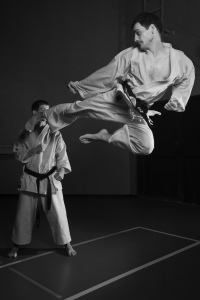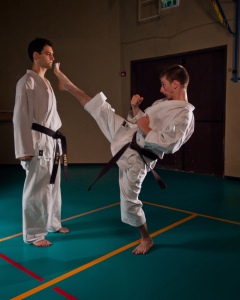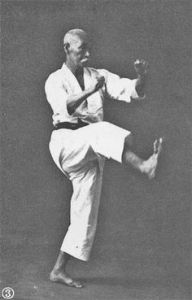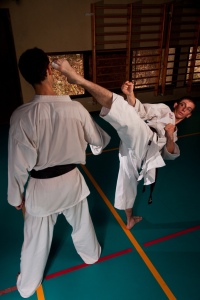 Many who begin the martial arts do so because they’re interested in self-defense. This is a worthy goal, but training for effective self-defense skills takes lots of effort. At the same time, many novices come to the martial arts expecting, and hoping, to become expert kickers. In fact, often when people think about the martial arts, kicking is the first type of technique that comes to mind, especially for the uninitiated. Kicking has its place in self-defense training, but it has a far more limited place than most people think.
Many who begin the martial arts do so because they’re interested in self-defense. This is a worthy goal, but training for effective self-defense skills takes lots of effort. At the same time, many novices come to the martial arts expecting, and hoping, to become expert kickers. In fact, often when people think about the martial arts, kicking is the first type of technique that comes to mind, especially for the uninitiated. Kicking has its place in self-defense training, but it has a far more limited place than most people think.
Now, a number of martial arts styles excel in kicking techniques. This is true of many Korean styles, like Tae Kwon Do and Tang Soo Do, but also of Japanese Karate styles like Shotokan. Northern Kung Fu styles also typically have reputations for many kicking techniques, and their forms often display quite a variety of long and high kicks. Other styles of martial arts–like Judo, Aikido, and Shuai Jiao–don’t have any kicking techniques to speak of (with the exception sometimes of using the feet for sweeping techniques that may resemble very low kicks).
So what place do kicking techniques have in self-defense? A very limited one. Before continuing, I want to clarify that my comments here are limited to actual self-defense, NOT competition or sports fighting, nor to the martial arts in general. The many flashy kicks (spinning, jump kicks, etc.) found in many popular styles like Tae Kwon Do, have their place, and an important one, in the practice of the martial arts for which kicking plays a prominent role. But self-defense on the street is a particular occasion for martial arts. Kicks can play an essential role in practicing and demonstrating kata or forms, but this is not directly related to self-defense (even if, I would argue, forms/kata training can indirectly help in self-defense…more on this to come on this blog).
 What benefit, what strength, can kicks bring to a self-defense situation? That depends on the situation. Each self-defense situation is unique. In general, kicks are one of the most powerful striking weapons a martial artist has in their unarmed arsenal. This should come as a no-brainer, since legs are the longest extension of the body (without weapons), and the muscles of the legs and rear (glutes), are the strongest of the body. Of course, kicking effectively and powerfully takes lots of training–and this is especially the case for kicking with precision. So, if you need to knock down a door without any tools, you don’t punch in the door, you try to kick it in.
What benefit, what strength, can kicks bring to a self-defense situation? That depends on the situation. Each self-defense situation is unique. In general, kicks are one of the most powerful striking weapons a martial artist has in their unarmed arsenal. This should come as a no-brainer, since legs are the longest extension of the body (without weapons), and the muscles of the legs and rear (glutes), are the strongest of the body. Of course, kicking effectively and powerfully takes lots of training–and this is especially the case for kicking with precision. So, if you need to knock down a door without any tools, you don’t punch in the door, you try to kick it in.
In the pictures I’ve included thus far (the jump kick at the top of this blog entry, and the face kick to the right), I feature the kind of flashy high kicks that look great in forms/kata demos, and are sometimes seen (and sometimes used effectively) in Karate and Tae Kwon Do tournaments.
For self-defense, however, I would recommend NEVER using high kicks. High kicks have their place in the martial arts, but in my opinion, kicking for self-defense situations, should be Limited to low kicks. Effective target areas, under very rare and special circumstances, might be as high as the bladder, floating ribs, or solar plexus, but only if your kicking is especially fast, the opening avails itself, and the scenario might be well-suited. The groin, the knee, the shin, and the top of the foot are much better targets, depending on the situation. How many self-defense seminars teach striking the testicles of a male attacker as a defensive maneuver? If a self-defense instructor teaches a groin strike–even hand techniques that involve ripping out the gonads–as a finishing technique, as a fail-proof way of defending oneself, then that tells me the instructor knows very little about actual self-defense. Such groin strikes are most effective as means of getting the opponent to move in a certain direction (e.g., bend down or perhaps loosen their grip). If the attacker is on drugs, or can’t feel pain, the groin strike will likely do very little to deter them—in fact, it probably won’t work at all. If they are determined to hurt you, it may only bend them over and make them tackle you to the ground. Groin strikes should never be used as the only technique in a self-defense situation, but should be used strategically, to get someone to loosen a grip (to enable you to run away, etc.), or bend them in a direction that will enable you to perform some other technique. We’ll talk more about practical self-defense in another post.
Knee strikes can be highly effective, but they are very dangerous, because legs break at the knee without much pressure at all. Knees are very sensitive joints, and can be injured without much effort. It takes a lot of practice to kick a knee without missing, but it doesn’t take much effort at all, to do very serious and even permanent damage by attacking the knee. Such a technique should only be used if the situation is a serious one where your potential bodily harm warrants such force. A strike to the knee is not a very good defense against the average school bully who is intent on pushing you around. It’s overkill. On the other hand, a kick to the knee can be an effective technique against a more dangerous assailant.
 Shin kicks are much like the groin kick, in that they won’t likely stop a serious threat, but they can help cause your attacker to loosen a grip, or move in a certain direction, or set you up for a further technique. The top of the foot (heel stomp to the shoe laces) is very sensitive and the bones there break fairly easily. This can be a helpful technique under the right circumstances. In general, though, you want your actual kicks in a self-defense scenario to be low and quick, thus avoiding as best as possible, the attacker blocking your strike (or worse, catching your leg or doing damage to your leg). In general, you probably don’t want to kick much higher than the kick depicted in the image to the left, which, I’d argue, is the image of the most effective kick for self-defense depicted by images in this blog post. The other images are an example of what not to do in self-defense. They may work in the movies…and they may work in the street, but I wouldn’t risk it if you’re in serious danger.
Shin kicks are much like the groin kick, in that they won’t likely stop a serious threat, but they can help cause your attacker to loosen a grip, or move in a certain direction, or set you up for a further technique. The top of the foot (heel stomp to the shoe laces) is very sensitive and the bones there break fairly easily. This can be a helpful technique under the right circumstances. In general, though, you want your actual kicks in a self-defense scenario to be low and quick, thus avoiding as best as possible, the attacker blocking your strike (or worse, catching your leg or doing damage to your leg). In general, you probably don’t want to kick much higher than the kick depicted in the image to the left, which, I’d argue, is the image of the most effective kick for self-defense depicted by images in this blog post. The other images are an example of what not to do in self-defense. They may work in the movies…and they may work in the street, but I wouldn’t risk it if you’re in serious danger.
 So should you practice high kicks if your style includes them and if you’re interested in self-defense but will only be using low kicks? YES, definitely, without a doubt!!! Why?!?! Because the more flexible your legs are, the higher you’re actually able to kick (and with power), the stronger, quicker, and more effectively you’ll be able to use those same kicks to lower targets. So if you develop a wicked fast and powerful side kick to someone’s temple (which could kill them if they didn’t move or block and let you perform that strike with serious power), how much more powerful would that same kick be to an opponent’s leg? In contrast, if you can only barely raise your leg to strike a kick at your opponent’s thigh, it will be less powerful when applied to the thigh than a fellow practitioner who applies the same kick to the thigh, but can kick over their head. So practice high kicks, if they’re in your martial art, and gain as much flexibility in your legs as possible, even if you’re interested primarily in self-defense. Just don’t train to use those high kicks in a self-defense situation, rather make sure you train regularly to attack more realistic targets.
So should you practice high kicks if your style includes them and if you’re interested in self-defense but will only be using low kicks? YES, definitely, without a doubt!!! Why?!?! Because the more flexible your legs are, the higher you’re actually able to kick (and with power), the stronger, quicker, and more effectively you’ll be able to use those same kicks to lower targets. So if you develop a wicked fast and powerful side kick to someone’s temple (which could kill them if they didn’t move or block and let you perform that strike with serious power), how much more powerful would that same kick be to an opponent’s leg? In contrast, if you can only barely raise your leg to strike a kick at your opponent’s thigh, it will be less powerful when applied to the thigh than a fellow practitioner who applies the same kick to the thigh, but can kick over their head. So practice high kicks, if they’re in your martial art, and gain as much flexibility in your legs as possible, even if you’re interested primarily in self-defense. Just don’t train to use those high kicks in a self-defense situation, rather make sure you train regularly to attack more realistic targets.